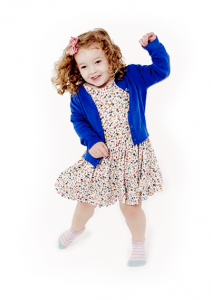
As you know, Music Together is a music and movement program. In class and at home, children and grownups participate in both large movement (e.g., dancing) and small movement (e.g., fingerplays) activities. In addition to helping build fine and gross motor skills, these help your child with other important movement skills essential to physical development, such as bilateral coordination and spatial awareness.

Experiencing a wide variety of ways to move helps children develop coordination, including bilateral coordination, the ability to use both sides of the body at the same time in a controlled and organized manner. There are several types of bilateral coordination, including:
- the ability to do the same movement using both sides of the body at the same time, such as picking up a block with two hands;
- moving in the same way but alternating sides of the body, such as walking;
- making different movements on each side of the body at the same time, such as throwing a ball with just one hand.
Since bilateral coordination requires both sides of the brain to communicate and share information, music activities that foster bilateral coordination also support brain development.
| Try this at home: Help your child experience different types of bilateral coordination. Put on a song with a great beat for dancing. Start by just moving to the music, first slowly, and then faster, using both sides and all parts of your bodies. Then try moving one body part on only one side and then the other. (For example, first raise and lower your right arm, then try the same movement with your left arm.) Finally, move both arms in the same way at the same time. Have fun and experiment with different body parts—knees or ears may be particularly fun! |
Dancing also helps children develop important spatial awareness skills, whether they are moving in place or through space—alone, with a partner, or in a group. Spatial awareness is the ability to understand the physical relationship between ourselves and the people and objects around us. This cognitive skill is naturally developed during dancing, as children pay attention to their own movements, the space they are moving in, and the movements of others. Spatial awareness assists your child in everything from lining up for recess, to running around in the playground, to giving you a hug.
So, as children wiggle, jump, tiptoe, stretch, bend, dance across the room, twirl scarves in a circle, and move with partners in Music Together, they are also developing complex physical skills that are essential to interacting with others and the world around them.



